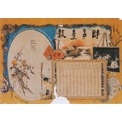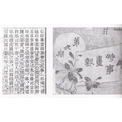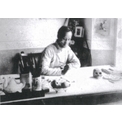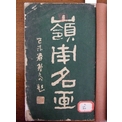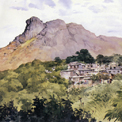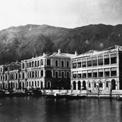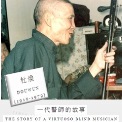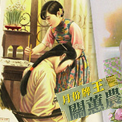 Collections
Collections A Eulogy of Hong Kong Landscape in Painting: The Art of Huang Bore
A Eulogy of Hong Kong Landscape in Painting: The Art of Huang Bore Biographical Notes of Huang Bore
Biographical Notes of Huang Bore
Compiled by Huang Dade
1901
Born in Dongguan, Guangdong. Originally named Jianbo, with the courtesy name as Bore (Cantonese: Wong Po-yeh) and literary names as Wanqian, Boruo, Boye, Manqian, Ruobo. His studio named as Siwuyang Zhai (Studio of the Four Intacts), Xiaohuangshan Guan (Mini-Mount Huang Studio), Huangshi Shanfang, Huangshi Zhai (Yellow Stone Studio), Zhuping’an Guan, Kuanhong Lou.
1903
After the death of his father, his small estate was seized by some clansmen. Huang and his mother fled to Guangzhou to live with his uncle Huang Shaomei.
1910
Studied in a private school for three years before dropping out owing to poverty. Then studied painting with uncle Huang Shaomei. Modelled bird-and-flower on Hua Yan, landscape on Shitao, and figure on Chen Hongshou, Jin Nong and Luo Pin.
Received the reformist ideas from Huang Shaomei and his friends including the revolutionary intellectual Pan Dawei, painter He Jianshi and Zheng Lüquan and took artistic reference from Shishi Huabao (Current Affairs Pictorial), Pingmin Huabao (People’s Pictorial) and Dianshizhai Huabao (Dianshizhai Pictorial).
1912
Brought by Pan Dawei and Huang Shaomei to Foshan and pretended to be beggar to experience life. After return, Pan Dawei and Huang Shaomei painted The Homeless People.
Under the mentoring of Pan Dawei, Wang Wei and Cai Shou. Through their introduction, Huang Bore came to know the artworks of master Huang Binhong and was impressed by Huang Binhong’s great accomplishments on art, literature and connoisseurship.
1917
Acquired a small painting by Huang Binhong through Cai Shou.
1919
His painting Autumn was published in the Famous Lingnan Painting.
1920
Began to learn advertising and art since this year when he worked with Huang Shaomei for the advertising section at Nanyang Brothers Tobacco Company which was directed by Pan Dawei.
1921
Participated in the first “Guangdong Provincial Fine Art Exhibition”.
Started producing cartoons under the influence of Pan Dawei, He Jianshi, Zheng Lüquan and Huang Shaomei, with works published in the supplement to Chinese Daily in Hong Kong.
Painted Eighteen Beauties.
1922
Used Bore as his common name and adopted his literary name as Wanqian. His father-in-law, Deng Erya, carved a seal of his name, Huang Bore, for him.
1923
Formed the Guihai Painting Cooperative with Pan Zhizhong, Zhoa Haogong, Huang Shaomei, Lu Zhenhuan, Yao Lixiu, Luo Zhuo and Lu Guanhai in Guangzhou. Later, Deng Fen, Lu Zishu, Huang Junbi, Zhang Guchu, He Guanwu and Li Yaoping also joined them.
Participated in the “Exhibition of Chinese Painting by Contemporaries” held by Pan Dawei at Pan Dawei’s Baoguang Photo Studio in Wellington Street, Hong Kong.
1924
Spring, painted Studio in Autumn Forest with Deng Fen for Gu Yingfen.
July. Guihai Painting Cooperative held its first exhibition which was managed by Huang Bore. His landscape, bird-and-flower, figure and collaborative paintings were featured. Classical paintings were also on display in the reference room.
Began to collect and study materials on the art of Su Liupeng and Su Renshan.
Frequently traveled to Hong Kong and resided in YMCA Bridges Street Hostel. Met Peng Xiangling who lived in the same hostel. Huang Bore had the chance of viewing Western painting catalogues as well as Chinese painting publications of Shenzhou Guoguang She kept by Peng Xiangling. Huang Miaozi often came to view with them to broaden the horizon.
1925
July. Guihai Painting Cooperative held its second exhibition. Huang Bore’s landscape, bird-and-flower, figure and collaborative paintings were featured.
Guihai Painting Cooperative grew to become the Chinese Painting Research Society.
There was then in Guangzhou a debate between the New School (Synthetic School) and the Traditionalist. The Chinese Painting Magazine, for which Huang Bore was editor-in-chief, in the Seventy-two Professions Commercial Daily published articles on the studies of Guangdong painting by Pan Zhizhong, Li Fenggong, Zhang Guchu, Huang Binhong, etc.
November. Wrote the article Essay on Advertising publishing on Seventy-two Professions Commercial Daily.
6th December. Members of the Chi Society and the Chinese Painting Research Society held a gathering and demonstration in the Guangdong First Garden.
1926
January. Complied the articles in Seventy-two Professions Commercial Daily and published as Collection of Chinese Painting Magazine which was the first publication on art theory in Guangdong.
Set up the Hong Kong branch of the Chinese Painting Research Society with Pan Dawei and Deng Erya. Published An Introduction on the Revised Constitution of Chinese Painting Research Society on Huaxing Bao in Hong Kong on 10th November.
Summer. Painted Dream of a Journey to Qixia for Deng Erya. Acquired another landscape painting by Huang Binhong through Cai Shou. Traveled to Shanghai, met and established friendship with Huang Binhong. Also became acquainted with Zhang Shanzi, Zhang Daqian, Wu Hufan, Zheng Wuchang, Yi Ru, Lu Danlin, etc.
Served as the editor of the tri-daily magazine The Search Light. Drew cartoons for various newspapers and magazines in the names of Bo, Boruo, Qian and Wan, revealing a strong influence from Huang Wennong, a cartoonist for Jing Bao in Shanghai.
Taught Chinese painting at the Hong Kong Government Vernacular Middle School.
1927
January. Painted Buddha.
February. Gao Jianfu instructed Fang Rending to write article “New Chinese Painting and Old Chinese Painting” which criticized members of the Chinese Painting Research Society as “conservative” and “old-fashioned”. 1st March. Huang Bore replied the criticism with the article “Is the New Chinese Painting Truly Chinese?” in Guomin Xinwen. This leaded to debate between traditionalists and Lingnan followers which lasted for half a year and died out following mediation by Ye Gongchuo.
May. Painted a female figure for Huang Lengguan.
Members of the Hong Kong branch of the Chinese Painting Research Society gathered in the Lee Garden during the Buddha Festival. Painted a collaborative painting with Pan Dawei for Lee Hysan.
Edited Special Publication of Chinese Painting Vol. 1, the journal of the Chinese Painting Research Society.
Traveled extensively in the mainland and re-visited Huang Binhong, etc.
1928
Served as the editor of the Feifei Illustrated Magazine.
Taught at the Hong Kong Government Vernacular Middle School. His landscape painting was published on the school’s quarterly magazine.
Mid-May. Holland artist A. Kets traveled to Hong Kong and held an exhibition at Hong Kong Hotel. Huang Bore visited the exhibition and met the artist with Li Ouzhai.
Huang Binhong went to lecture in Guangxi via Hong Kong. Huang Bore received the artist and accompanied Huang Binhong traveling around Hong Kong and making sketches. Obtained paintings as gifts from Huang Binhong.
August. Special Publication of Chinese Painting Vol.2 was published.
December. First published Xianyan Bao with Pan Dawei in Hong Kong to preach Buddhism.
1929
Set up the Elm Society with Zhang Guchu, Huang Junbi, Lu Zishu, Li Yanshan, etc.
June. Jointly organized an exhibition of paintings by students at the Commercial Press (Hong Kong) in Queen’s Road Central with Bao Shaoyou.
September. Edited the magazine Impression with Chen Jinghong.
1st November. “The Chinese and Japanese Modern Painting Exhibition” opened. Huang Bore’s painting was on display.
Obtained a flower painting as gift from Gao Qifeng.
1930
Painted Luohan under the Banana Tree.
February. Participated in “Chinese Painting and Calligraphy Exhibition of the Gengwu Year” at the Southwest Girl’s Middle School in Bonham Road, Hong Kong.
March. Founded the Chinese Fine Art Institute in Hong Kong with Qiu Daiming and Wu Meihe to teach Chinese and Western painting and photography, etc. Outdoor sketching trips were also arranged on Saturdays and Sundays.
Widely traveled in Zhejiang and visited Huang Binhong in Shanghai. Received a handscroll of Guilin landscape from Huang Binhong and painted Journey to Zhejiang.
Received a few sketches of Mount Lushan from Zhang Guchu.
15th August. Participated in the painting exhibition held by Banlan Society at the Queen’s Hotel. Participants also included: Deng Erya, Huang Shaomei, Li Ouzhai and Li Yanshan.
October. Participated in the exhibition held by the Chinese Fine Art Institute and Zhendan Painting Society with Huang Shaomei.
October. Over 180 works called by Ye Gongchuo were featured in the Chinese painting exhibition held at the Belgium Expo. Huang Bore’s painting was awarded a silver medal.
November. YMCA started to organize the “Exhibition of Hong Kong Art” and appointed Huang Bore as the director of promotion.
1931
March. Participated in the “Exhibition of Hong Kong Art”.
1932
August. Re-visited Shanghai.
Obtained a painting as gift from Pan Feisheng.
1933
January. Appointed as a member of art committee of the “Guangzhou Municipal Art Exhibition”. His bird-and-flower painting selected for the exhibition was published on the Special Publication of Chinese Painting – Guangzhou Municipal Art Exhibition.
February. The “Art Exhibition of Nationwide Artists’ Donations to the Northeastern Army of Volunteers” was jointly organized by the Shanghai Society for Backing Up the Northeastern Army of Volunteers, United Association of the Republic of China Bodies to Save the Country, and Chinese Painting Society. Huang Bore together with Ye Gongchuo, He Xiangning, Chen Shuren, Zhao Haogong, etc., served as members of the organizing committee.
Autumn. Accompanied Zhang Daqian to Victoria Peak during the stay of Zhang Daqian in Hong Kong. Zhang Daqian presented a painting to Huang Bore as a gift and inscribed on Huang Bore’s Bodhidharma.
Traveled to Suzhou with Huang Miaozi. Got a small piece of yellow stone, the shape of which resembled Mount Huang. Thus named his studio Xiaohuangshan Guan (Mini-Mount Huang Studio). Zhang Daqian and Wu Hufan jointly painted Yellow Stone Studio for Huang Bore. Deng Erya also carved Huang Bore a seal with the studio name.
1934
Traveled to Shaozhou, Nanhua, Danxia. Re-visited Guilin and Luofu.
Collected a flower painting of Niu Shihui, from which Huang Bore acquired the studio name of Siwuyang Zhai (Studio of the Four Intacts). Deng Erya again carved Huang Bore a seal.
Two of Huang Bore’s paintings were on display in the “Exhibition of Chinese Painting” held in Berlin.
Published the article Early Summer in Xuanwu Lake with photographs on The Companion Pictorial in Shanghai.
1935
July. Huang Binhong went to lecture in Guangxi via Hong Kong. Huang Bore received the artist and guided Huang Binhong to tour around Hong Kong with Tang Tianru, Li Gongci and Deng Erya. Took portrait photographs for Huang Binhong during the stay of Huang Binhong.
Afterward, Huang Binhong re-visited Hong Kong during his returning trip from Guangxi. Huang Bore accompanied Huang Binhong touring Kowloon and New Territories with Li Jingkang and others, and discussed art with Huang Binhong at Li Jingkang’s Shatin villa. Chen Fan took record of the discussion and entitled it Discussion on Art in Shatin.
1936
Published photographs on nudes taken by himself in The Companion Pictorial in July and September, and photographs on sceneries of Guangdong in November.
1937
Xu Beihong toured to Hong Kong for exhibition. During his stay, he visited Huang Bore and showed his collection of Illustration of the Immortals Lined up before their Originator to Huang Bore for consultation. When Xu Beihong saw Huang Bore’s copy, he insisted on exchanging for it with his own paintings but failed. Then Xu Beihong severed his ties with Huang Bore.
1938
Fang Rending toured to Hong Kong for exhibition. Through introduction by Lu Danlin, Huang Bore first met Fang Rending and they became good friend.
1939
October. The Chinese Culture Association was founded in Hong Kong and Huang Bore was appointed as a member of the art committee.
1940
14th January, Zhang Daqian moved his collection from Shanghai back to Sichuan via Hong Kong. Zhang Daqian discussed art with Ye Gongchuo, Jian Youwen, Xu Dishan and Huang Bore in Hong Kong.
Appointed as an ExCo member of The Chinese Culture Association.
24th April. Participated and spoke in the seminar “Painting in Guangdong” organized by The Chinese Culture Association.
October. Appointed as the director of the art committee of The Chinese Culture Association.
16th November. Together with He Guanwu and Jiale Yuan, organized the “Exhibition of Paintings by the Four Monks in Late Ming” at the Fung Ping Shan Library of The University of Hong Kong, and chaired the seminar “Paintings by the Four Monks in Late Ming”.
Served as the Director of General Affairs for the “Guangdong Heritage Exhibition” organized by The Chinese Culture Association at the Fung Ping Shan Library of The University of Hong Kong. After the exhibition, worked with Ye Gongchuo, Jian Youwen, Huang Cibo, Xu Dishan and Li Jingkang to edit the three voluminous volumes of Guangdong Heritage.
1941
1st January. Jian Youwen received Huang Bore, Liu Yazi, Xu Dishan, Lu Danlin, etc., as guests in Kowloon.
May. Participated in the “Modern Chinese Painting Exhibition”. Organized and donated to a fund-raising exhibition in order to support the Guangdong army resisting the Japanese troops.
31st May. Held a three-person painting exhibition with Zhao Haogong and Lu Zhenhuan at Cecil Hotel.
Painted Chang’e, Buddha, etc.
November. Re-appointed as an ExCo member and a member of the art committee of The Chinese Culture Association.
Collected artworks by Su Renshan and Su Liupeng with Ye Gongchuo, Huang Miaozi, etc., in preparation of an exhibition. The exhibition, however, was preempted by the Japanese occupation of Hong Kong one week before the opening.
1942
Painted Luohan.
Returned to Northern Guangdong. October. Painted the Records of the Flee to Northern Guangdong.
1943
Painted Guanyin Bodhisattva above Clouds of Fire, Guanyin Bodhisattva, Bird and Red Leaves.
1945
Painted Peach Blossom Spring for Deng Erya and Deng Erya inscribed the painting with the poems and essay of the Peach Blossom Spring by Tao Yuanming. Painted Guanyin Bodhisattva.
1946
January. The Guangdong Document Archive was established. Worked with the registration department to take care of art and antiquities, and organized monthly art appreciation meetings. Collected 2792 rare books and about 6000 artworks and cultural relics for the Archive.
July. Held an exhibition of paintings of refugees by Ye Yinquan at the Guangdong Document Archive and caused a sensation in Guangzhou.
21st-23rd August. Moved the exhibition of paintings of refugees by Ye Yinquan to display at YMCA Bridges Street Center in Hong Kong.
17th November. Worked with Zhao Haogong for reviving the Chinese Painting Research Society.
1947
2nd January. Held an art exhibition at the Huangtu Gallery in Guangzhou with Feng Gangbai, Hu Gentian, etc.
29th January. “The Chinese Heritage Exhibition” initiated and organized by Huang Bore with Zheng Defen and Pan Xi was held at the Northcote Training College in Hong Kong. Wrote articles for newspapers in Guangzhou and Hong Kong to promote the exhibition.
After “The Chinese Heritage Exhibition”, oversaw the return of exhibits to Guangzhou by sea. The Xi’an ship caught fire at mid-night and most of the exhibits were destroyed. Huang Bore managed to salvage several of the most valuable paintings, which became a household story in the arts circle.
September. Published the articles Portrait of Monk Dashan and Bada Shanren and Niu Shihui on Zhongshan Ribao (Zhongshan Daily).
Appointed as member of the editorial board of Guangdong Heritage along with Ye Gongchuo, Rao Zongyi, Rong Geng, etc.
October. Held an exhibition of “Huang Bore’s Recent Works and His Collection of Painting and Calligraphy” at the Guangdong Document Archive.
October. Initiated with Zhao Haogong, Hu Gentian, Li Yanshan and Wu Qianli a painting exhibition jointly organized by the Guangdong Art Association, the Chinese Painting Research Society and Alumni Association of the Guangzhou Municipal College of Fine Arts. The exhibition was held at the Zhongshan Library in Guangzhou.
November. Appointed as a member of the organizing committee for a fund-raising exhibition for the Zhongshan Library.
1948
Served as the editor of the Special Publication of Guangdong Heritage.
May. Published articles on paintings of Su Renshan on a magazine and a newspaper in Hong Kong and Guangzhou respectively.
June. Published an article about Monk Tianran on Yuehua Bao in Guangzhou.
15th August. Wrote an article for The Special Publication of Huang Junbi’s Painting Exhibition on Sing Tao Daily in Hong Kong.
October. Published an article to introduce Su Liupeng on Daguang Bao in Guangzhou.
Founded the Yuan Painting Society with Lu Yougnag, Li Yanshan, Lu Zhenhuan, Lin Qingni, Lin Jiantong, etc., and held an exhibition at the Guangdong Document Archive on 16th October. Three of his paintings were displayed in the exhibition.
Loaned out his collection for an exhibition of Guangdong contemporary masterpieces held by Lin Jiantong in Taiwan.
13th December. Wrote an article for The Special Publication of the Retrospective Exhibition of Zhao Haogong on Sing Tao Daily in Hong Kong.
1949
January. In charge of the editorial works for the column “Masterpieces of Painting and Calligraphy” created by Yang Society (Ram Society) in Yuehua Bao.
Came up with a proposition to found the Yuanpei Art School in Guangzhou with Li Yanshan, Li Yuzhong, etc.
February. The KMT presidential office was moved to Guangzhou and the Guangdong Document Archive was used as the temporary office of the National Archive. Huang Bore resigned from the Guangdong Document Archive and settled in Hong Kong.
April. Feng Zikai traveled to Hong Kong. Huang Bore organized a painting exhibition of Feng Zikai at the auxiliary hall of the St. John’s Cathedral with Ye Gongchuo.
Painted Guanyin Bodhisattva and presented a landscape painting for Wu Baling as gift.
1950
New year day. Held a joint exhibition with Ye Yinquan at Cecil Hotel in Hong Kong.
Beginning from the early 1950s, went hiking with the Yung Sheh Hiking Club to even the remotest spots of Hong Kong, taking in the views and capturing landscapes in painting.
Rented a room in Cecil Hotel with the oil painter Xu Dongbai as their painting studio. Also hired the meeting room of the Cecil Hotel to run his gallery selling Chinese painting and calligraphy.
1951
May. Published the article Portrait and Art – A Preface of the Exhibition of Oil Painting by Xu Dongbai on Wah Kui Yat Po.
Painted Kapok, Peach Blossom Spring, etc.
1952
Invited by Rong Geng, on behalf of the Guangzhou Municipal Government, to return to Guangzhou to work in the Guangdong Cultural Relics Administrative Bureau to take charge of the art and antiquity departments. Huang Bore declined the offer.
1953
Painted Portrait of Mo Tianyi, Portrait of Tang Yusheng.
1955
8th July. Published the article A Review on the Cultural Relics and Art Exhibitions in Hong Kong in the Past Three Decades on The Kung Sheung Daily News.
1956
Inspired by the sequent fires at slums in Kowloon in the 1950s, painted a series of Fire in Kowloon.
25th March. Joined the Yung Sheh Hiking Club for a trip to Ap Chau, then painted a series of Ap Chau.
1st April. Joined the Yung Sheh Hiking Club for a trip to Po Toi Island.
Summer. Visited to Northern and Eastern China at the invitation of the New China News Agency, Hong Kong Branch with friends from the arts circle including Yu Ben (Yee Bon), Xu Dongbai and Zheng Jiazhen.
Established the Ping Sheng Art Club with Bao Shaoyou, Ding Yanyong, Zhao Shao’ang, Yang Shanshen, etc., and participated in the first exhibition of the Club.
27th October. Joined the Yung Sheh Hiking Club for a night hike to Lantau Peak, then painted Climbing the Lantau Peak at Night.
Painted Lantau Island, Lantau Peak, Victoria Peak, Aberdeen, Spring in Shatin, etc.
1957
Painted Sung Wong Toi.
Appointed as juror of the “Southeast Asian Touring Exhibition of Chinese Painting” organized by the Chinese Art Club of Hong Kong. Submitted his Lantau Peak to the exhibition.
March. Founded the Seven Person Painting Club with Li Yanshan, Zhao Shao’ang, Yang Shanshen, Li Xipeng, Ding Yanyong and Lu Shoukun. Participated in their group exhibition held at the St. John’s Cathedral with his ten paintings of Hong Kong scenery.
1958
Served as a serving member for the Yung Sheh Hiking Club till 1968.
May. Toured to Tin Hau Temple in Sai Kung with Jian Youwen and Wu Baling (Ng Bar Ling), then painted Fat Tong Mun.
Painted the series of Hong Kong Fishing Village and Hong Kong Scenery.
1959
January. Participated in the joint exhibition of painting and calligraphy organized by the Hong Kong arts circle in support of the building of a Workers’ City Hall. Produced several paintings of Hong Kong scenery.
October. Held the “Exhibition of Paintings by Five Contemporary Chinese Masters” which exhibited the masterpieces of Ren Bonian, Wu Changshou, Qi Baishi, Huang Binhong and Xu Beihong at The Chinese General Chamber of Commerce in Hong Kong. Edited and wrote article for the catalogue.
1960
February. Wrote the article Sketches by Luo Ming.
March. Re-visited various places in China. Painted The Five-Storey Pavilion in Guangzhou.
23rd March. Participated in the annual exhibition of the Ping Sheng Art Club and featured a series of Pat Sin Leng.
April. The Alumni Association of the Hong Kong Government Vernacular Normal School held an arts exhibition at the auxiliary hall of the St. John’s Cathedral. Huang Bore exhibited photographic works Po Toi O and Hong Kong.
30th April. Attended the celebration of May First International Labour Day at the Great Hall of People in Beijing at the invitation of the State Council of the People’s Republic of China.
July. Organized the “Exhibition of Chinese Bonsai, Painting and Calligraphy” together with some thirty artists, including Gao Zhengbai and Deng Fen.
22nd August. Held a solo exhibition “Paintings of Hong Kong” at the auxiliary hall of the St. John’s Cathedral.
1st November. Gave a lecture on “Sketching in Chinese Painting” for the Sixth Hong Kong Arts Festival.
10th November. Published the article A Brief on Wu Yongguang’s Brush Stand and Shiwan Ceramics on Ta Kung Pao.
December. Held a ten-person exhibition of Chinese painting at the auxiliary hall of the St. John’s Cathedral with Li Fanfu, Ren Zhenhan, Zheng Jiazhen, Li Xunping, etc.
Joined the Gengzi Painting Society.
Wrote a series of article on Guangdong art history for Ta Kung Pao and Wah Kui Yat Po since this year.
1961
Visited the Northeast China and made sketches.
1st October. Participated in a painting exhibition of scenery in China with Li Fanfu, Chen Haiying and Huang Chaokuan and featured Celebrating the Completion of Shenzhen Dam and Coal Mining in Fushun.
20th October. Held the “Exhibition of Painting and Calligraphy by Guangdong Masters” organized by Ta Kung Pao at The Chinese General Chamber of Commerce in Hong Kong.
Participated in the cartoon exhibition held by the Cartoon World of Hong Kong and attended its gathering.
1962
Appointed as the honorary advisor of the newly established City Hall Museum and Art Gallery (Now the Hong Kong Museum of Art).
March. Held the second ten-person exhibition of Chinese Painting at the Hong Kong City Hall. Featured Lamma Island, Luohan, etc.
June. Wrote the article A Little Painter with Great Talent.
Participated in the 2nd International Salon of Arts, Hong Kong.
1963
Painted Hong Kong Scene.
1964
Attended a gathering of Hong Kong cartoonists in which the artists jointly produced the work Spring Outing of Cartoon Figures.
March. Participated in a painting exhibition to raise education fund for poor children.
June. Taught as a volunteer at the youth Chinese painting course organized by the Western District Kaifong Welfare Association.
Summer. On invitation, traveled to China again and made sketches. Met old friends including Huang Yongyu and Huang Miaozi in Beijing.
1965
2nd-7th April. Held “An Exhibition of Paintings by Eleven Artists” together with Li Fanfu, Ren Zhenhan, Li Xunping, Zheng Jiazhen, Huang Chakuan, Liu Caoyi, Liang Daoping, Wu Buyun, Wu Geng and Lu Juchuan at the Hong Kong City Hall. Exhibited ten paintings of scenery of China inspired by his visit to China.
1966
Painted The Cliff Island, Coming Storm, Fishing Village, Strange Rocks in Ping Chau, etc.
On invitation, lectured and demonstrated Chinese painting on the art forum organized by the Extra–mural Studies Department of The Chinese University of Hong Kong.
1967
Painted a series of Fishing Boats.
1968
Painted Buffalos, Fishing Boats, etc.
17th August. Passed away of cirrhosis and gastrorrhagia in Hong Kong. According to his will, a part of his collection of Guangdong painting and his own works were donated to the City Hall Museum and Art Gallery.
1969
The “Commemorative Exhibition of Paintings by Wong Po-yeh” was organized by the City Hall Museum and Art Gallery. The catalogue, Wong Po-yeh, was published.
1971
December. A retrospective exhibition of Huang Bore was held at the Tsi Ku Chai Company in Hong Kong and The Painting of Huang Bore was published.
1995
20th December. “The World of Wong Po-yeh” exhibition was organized by the Art Museum and Institute of Chinese Studies of The Chinese University of Hong Kong and The World of Wong Po-yeh was published.
Album of Hong Kong Sketches, Below Victoria Peak, Pat Sin Leng, Sung Wong Toi, etc., were donated to the Art Museum of The Chinese University of Hong Kong.
1996
23rd July-3rd August. “The World of Wong Po-yeh” exhibition jointly presented by Guangdong Artists Association and Guangzhou Museum of Art was held at the Guangzhou Museum of Art.
1997
9th September. “Huang Bore’s World of Art” exhibition jointly presented by the China Artists’ Association, Art Museum of The Chinese University of Hong Kong and Guangzhou Museum of Art was held at the National Art Museum of China in Beijing. Collection of Art Writings by Huang Bore was published by Renmin Meishu Chubanshe and a forum on the art of Huang Bore was held by the China Artists’ Association.
2001
October. “The Art of Huang Bore” exhibition in celebration of the 100th birthday of the artist was held at the Guangdong Museum of Art.
